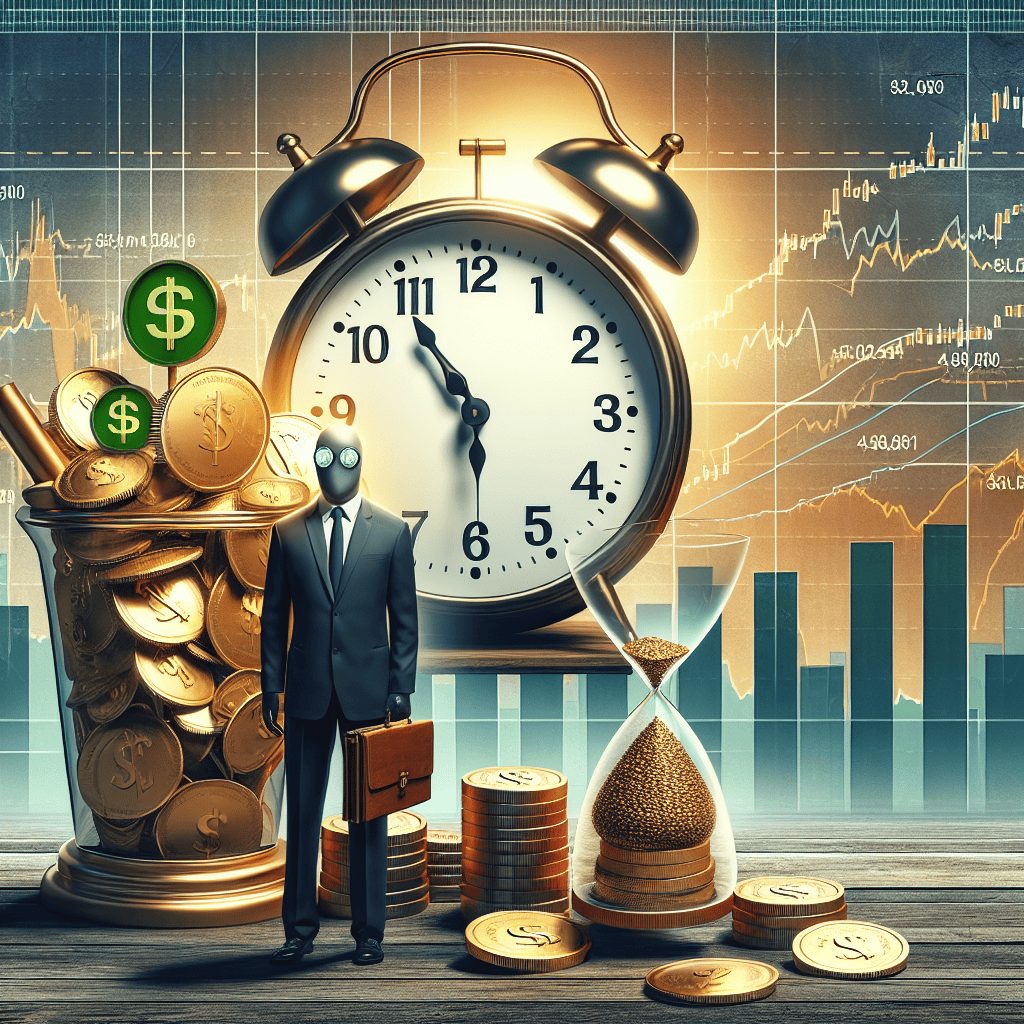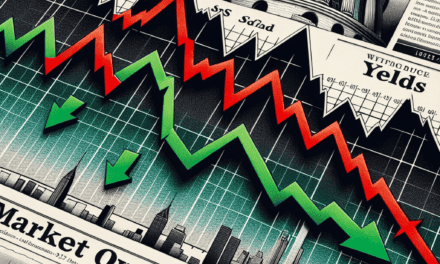“Seize the Opportunity: Invest in the High-Yield Dividend Stock Backed by Billionaire Insight!”
Introduction
In the ever-evolving landscape of financial markets, investors constantly seek opportunities that promise substantial returns. One such opportunity that has garnered significant attention is the high-yield dividend stock backed by billionaire investor Stanley Druckenmiller. Known for his astute investment strategies and impressive track record, Druckenmiller’s endorsement of a stock often signals potential for lucrative gains. However, as with any investment, timing is crucial. The question on many investors’ minds is whether it is too late to capitalize on this high-yield dividend stock. As market dynamics shift and economic conditions fluctuate, assessing the viability of this investment requires a careful examination of current market trends, the stock’s performance, and the broader economic context.
Understanding High-Yield Dividend Stocks: A Beginner’s Guide
High-yield dividend stocks have long been a cornerstone for investors seeking both income and growth. These stocks, known for their ability to provide substantial dividend payouts, attract a wide range of investors, from retirees looking for steady income to younger investors aiming to reinvest dividends for compounded growth. The allure of high-yield dividend stocks lies in their dual potential to offer regular income and capital appreciation. However, the question of timing often looms large in investment decisions, particularly when a prominent figure like billionaire Stanley Druckenmiller endorses a specific stock. This raises the question: is it too late to invest in the high-yield dividend stock that Druckenmiller backed?
To address this question, it is essential to understand the nature of high-yield dividend stocks. These stocks typically belong to well-established companies with a history of stable earnings and a commitment to returning profits to shareholders. The high yield is often a reflection of the company’s strong cash flow and its ability to sustain dividend payments even during economic downturns. However, a high dividend yield can sometimes signal underlying risks, such as a declining stock price or potential financial instability. Therefore, investors must conduct thorough research to ensure that the high yield is not a result of unsustainable business practices.
When a seasoned investor like Stanley Druckenmiller endorses a high-yield dividend stock, it can generate significant interest and influence market perceptions. Druckenmiller’s investment decisions are often based on rigorous analysis and a deep understanding of market dynamics, which can provide a level of reassurance to other investors. However, it is crucial to remember that past performance is not always indicative of future results. While Druckenmiller’s backing may suggest confidence in the stock’s potential, individual investors should consider their own financial goals, risk tolerance, and investment horizon before making a decision.
Moreover, the timing of an investment can impact its success. While it may seem advantageous to follow the lead of a successful investor, market conditions and individual circumstances can vary significantly. For instance, a stock that was an attractive investment at the time of Druckenmiller’s endorsement may have experienced changes in its financial health, industry dynamics, or broader economic conditions. Therefore, it is important for investors to stay informed about any developments that could affect the stock’s performance.
In addition to timing, diversification is a key principle in managing investment risk. Relying heavily on a single high-yield dividend stock, even one backed by a renowned investor, can expose an investor to unnecessary risk. By diversifying across different sectors and asset classes, investors can mitigate potential losses and enhance their portfolio’s resilience.
In conclusion, while the endorsement of a high-yield dividend stock by a billionaire investor like Stanley Druckenmiller can be compelling, it is not the sole factor to consider when making an investment decision. Understanding the fundamentals of high-yield dividend stocks, assessing the timing and market conditions, and maintaining a diversified portfolio are all critical components of a successful investment strategy. By taking these factors into account, investors can make informed decisions that align with their financial objectives and risk tolerance, ensuring that they are well-positioned to achieve their long-term goals.
Analyzing Stanley Druckenmiller’s Investment Strategies
Stanley Druckenmiller, a renowned billionaire investor, has long been admired for his astute investment strategies and ability to navigate complex financial markets. His recent backing of a high-yield dividend stock has sparked considerable interest among investors, prompting many to question whether it is too late to capitalize on this opportunity. To understand the potential of this investment, it is essential to delve into Druckenmiller’s investment philosophy and the factors that may have influenced his decision.
Druckenmiller’s investment approach is characterized by a keen focus on macroeconomic trends and a willingness to take calculated risks. He is known for his ability to identify undervalued assets and capitalize on market inefficiencies. This strategy has served him well over the years, allowing him to achieve impressive returns. When Druckenmiller invests in a high-yield dividend stock, it is likely that he has identified a compelling opportunity that aligns with his broader market outlook.
High-yield dividend stocks are particularly attractive to investors seeking steady income streams, especially in a low-interest-rate environment. These stocks typically belong to companies with strong cash flows and stable business models, which enable them to distribute a significant portion of their earnings to shareholders. Druckenmiller’s endorsement of such a stock suggests that he sees potential for both income generation and capital appreciation.
However, the question remains: is it too late for other investors to follow suit? To answer this, one must consider the current market conditions and the specific attributes of the stock in question. While Druckenmiller’s involvement may have already driven up the stock’s price, it is important to assess whether the underlying fundamentals still justify further investment. Investors should examine the company’s financial health, competitive position, and growth prospects to determine if the stock remains a viable option.
Moreover, it is crucial to recognize that Druckenmiller’s investment decisions are informed by his unique insights and access to information that may not be readily available to the average investor. While his backing of a stock can be seen as a vote of confidence, it is not a guarantee of future success. Investors must conduct their own due diligence and consider their individual risk tolerance and investment objectives before making any decisions.
In addition, the broader economic landscape plays a significant role in determining the viability of investing in high-yield dividend stocks. Factors such as interest rate fluctuations, inflationary pressures, and geopolitical uncertainties can all impact the performance of these investments. As such, investors should remain vigilant and adaptable, ready to adjust their strategies in response to changing market conditions.
In conclusion, while Stanley Druckenmiller’s endorsement of a high-yield dividend stock may present an enticing opportunity, it is not without its risks. Investors must carefully evaluate the stock’s fundamentals, consider their own financial goals, and remain cognizant of the broader economic environment. By doing so, they can make informed decisions and potentially benefit from the insights of one of the most respected investors in the industry. Ultimately, whether it is too late to invest in this stock depends on a thorough analysis of these factors and a willingness to embrace the inherent uncertainties of the financial markets.
The Pros and Cons of Investing in High-Yield Dividend Stocks
Investing in high-yield dividend stocks has long been a strategy favored by many investors seeking a steady income stream and potential capital appreciation. The allure of these stocks is particularly compelling in a low-interest-rate environment, where traditional fixed-income investments may not offer sufficient returns. However, the question of whether it is too late to invest in a high-yield dividend stock, especially one backed by a prominent figure like billionaire Stanley Druckenmiller, requires a nuanced examination of both the advantages and potential pitfalls associated with such investments.
One of the primary benefits of investing in high-yield dividend stocks is the opportunity for regular income. These stocks typically distribute a significant portion of their earnings to shareholders in the form of dividends, providing a reliable income stream that can be particularly attractive to retirees or those seeking passive income. Moreover, companies that consistently pay high dividends often exhibit strong financial health and stable cash flows, which can be indicative of a well-managed business. This stability can offer investors a degree of reassurance, especially during volatile market conditions.
In addition to income generation, high-yield dividend stocks can also contribute to portfolio diversification. By including these stocks in a broader investment strategy, investors can potentially reduce overall portfolio risk. This is because dividend-paying stocks often belong to established companies with a history of profitability, which can act as a buffer against market downturns. Furthermore, the reinvestment of dividends can lead to compounding returns over time, enhancing the potential for long-term wealth accumulation.
However, despite these advantages, there are inherent risks associated with high-yield dividend stocks that investors must consider. One significant concern is the sustainability of the dividend itself. A high yield may sometimes be a red flag, indicating that the company is under financial stress and may not be able to maintain its dividend payments in the future. This risk is exacerbated if the company faces declining revenues or increased debt levels, which could lead to dividend cuts or suspensions, ultimately impacting the stock’s price and investor returns.
Additionally, high-yield dividend stocks may be more sensitive to interest rate fluctuations. As interest rates rise, the relative attractiveness of dividend stocks may diminish, as investors could shift their focus to fixed-income securities offering higher yields. This shift in investor sentiment can lead to price volatility and potential capital losses for those holding high-yield dividend stocks.
Considering these factors, the decision to invest in a high-yield dividend stock, even one endorsed by a seasoned investor like Stanley Druckenmiller, should be approached with careful analysis and due diligence. Investors should assess the company’s financial health, dividend history, and growth prospects to determine whether the stock aligns with their investment objectives and risk tolerance. It is also prudent to consider the broader economic environment and how it may impact the company’s ability to sustain its dividend payments.
In conclusion, while high-yield dividend stocks can offer attractive benefits, they are not without their challenges. The key to successful investing in this arena lies in balancing the potential for income and growth with the associated risks. By conducting thorough research and maintaining a diversified portfolio, investors can better position themselves to capitalize on the opportunities presented by high-yield dividend stocks, regardless of market conditions or the endorsements of influential investors.
Timing the Market: Is It Ever Too Late to Invest?

Investing in the stock market often feels like navigating a labyrinth, with investors constantly seeking the right path to maximize returns. The allure of high-yield dividend stocks is particularly strong, offering the promise of regular income alongside potential capital appreciation. When a renowned investor like billionaire Stanley Druckenmiller backs a particular stock, it naturally garners significant attention. However, the question that arises is whether it is too late to invest in such a stock, especially after it has already been endorsed by a financial luminary.
Timing the market is a challenge that even seasoned investors struggle with. The concept of buying low and selling high is simple in theory but notoriously difficult in practice. Market conditions are influenced by a myriad of factors, including economic indicators, geopolitical events, and investor sentiment, all of which can change rapidly. Consequently, the idea of perfect timing often remains elusive. In this context, the decision to invest in a high-yield dividend stock that has already been identified by a prominent investor like Druckenmiller requires careful consideration.
One of the key factors to consider is the stock’s current valuation. A stock that has been endorsed by a billionaire investor may experience a surge in demand, driving up its price. This can lead to a situation where the stock becomes overvalued, potentially diminishing future returns. Therefore, it is crucial to assess whether the stock’s current price accurately reflects its intrinsic value. This involves analyzing the company’s financial health, growth prospects, and the sustainability of its dividend payouts. A thorough evaluation can help determine if the stock still offers a compelling investment opportunity or if the market has already priced in the potential benefits.
Moreover, it is important to consider the broader market environment. High-yield dividend stocks are often favored during periods of economic uncertainty, as they provide a steady income stream. However, in a rising interest rate environment, these stocks may face headwinds, as investors might shift their focus to fixed-income securities that offer competitive yields. Understanding the macroeconomic landscape can provide valuable insights into the potential risks and rewards associated with investing in such stocks.
Another aspect to consider is the investor’s own financial goals and risk tolerance. While high-yield dividend stocks can be an attractive addition to a diversified portfolio, they may not align with every investor’s objectives. For those seeking long-term growth, the focus might be on companies with strong reinvestment opportunities rather than those prioritizing dividend payouts. Conversely, income-focused investors may find high-yield dividend stocks to be a suitable fit, provided they are comfortable with the associated risks.
In conclusion, while the endorsement of a high-yield dividend stock by a billionaire investor like Stanley Druckenmiller can be a compelling reason to consider an investment, it is not the sole factor to rely on. Investors must conduct their own due diligence, taking into account the stock’s valuation, the prevailing market conditions, and their personal financial goals. By doing so, they can make informed decisions that align with their investment strategy, rather than being swayed solely by the actions of prominent figures in the financial world. Ultimately, the question of whether it is too late to invest is less about timing the market perfectly and more about understanding the underlying value and potential of the investment.
The Impact of Billionaire Endorsements on Stock Performance
The influence of billionaire endorsements on stock performance is a topic that has garnered significant attention in the financial world. When a renowned investor like Stanley Druckenmiller backs a particular stock, it inevitably raises questions about the potential impact on the stock’s future performance. Investors often wonder whether it is too late to invest in such high-yield dividend stocks once they have received the endorsement of a financial titan. To understand this phenomenon, it is essential to explore the dynamics of billionaire endorsements and their effects on stock performance.
Billionaire endorsements can serve as a powerful catalyst for stock price movements. When a well-respected investor like Druckenmiller publicly supports a stock, it can lead to increased investor interest and confidence. This heightened attention often results in a surge in demand, driving up the stock price. Consequently, early investors who acted on the endorsement may benefit from significant capital gains. However, this initial surge can also create a dilemma for potential investors who are late to the party. They may question whether the stock has already reached its peak and if further investment would yield diminishing returns.
Moreover, the impact of a billionaire endorsement is not solely confined to short-term price movements. It can also influence the long-term perception of the stock. When a seasoned investor like Druckenmiller backs a company, it can be seen as a validation of the company’s business model, financial health, and growth prospects. This endorsement can attract institutional investors and analysts, leading to increased coverage and a more favorable outlook for the stock. As a result, the stock may experience sustained growth over time, providing opportunities for long-term investors.
However, it is crucial to recognize that not all billionaire endorsements guarantee success. The stock market is inherently unpredictable, and even the most astute investors can make misjudgments. While Druckenmiller’s backing may indicate confidence in the stock, it does not eliminate the inherent risks associated with investing. Market conditions, economic factors, and company-specific challenges can all impact the stock’s performance, regardless of the endorsement it receives. Therefore, potential investors should conduct thorough research and consider their risk tolerance before making investment decisions.
In addition, the timing of an investment following a billionaire endorsement is a critical factor to consider. While early investors may benefit from the initial surge in stock price, those who enter the market later may face a different risk-reward scenario. The stock may have already experienced significant appreciation, reducing the potential for substantial gains. However, if the endorsement leads to sustained growth and improved fundamentals, latecomers may still find value in the investment over the long term.
In conclusion, the impact of billionaire endorsements on stock performance is multifaceted. While such endorsements can lead to immediate price surges and increased investor confidence, they do not guarantee success. Potential investors must carefully evaluate the stock’s fundamentals, market conditions, and their investment goals before making decisions. Although it may seem daunting to invest in a high-yield dividend stock that has already received a billionaire’s backing, the potential for long-term growth and value creation remains. Ultimately, the decision to invest should be based on a comprehensive analysis rather than solely on the endorsement itself.
Diversifying Your Portfolio with High-Yield Dividend Stocks
Investing in high-yield dividend stocks has long been a strategy favored by those seeking to diversify their portfolios while generating a steady stream of income. Among the myriad of options available, certain stocks gain prominence due to endorsements from influential investors. One such stock, recently backed by billionaire Stanley Druckenmiller, has captured the attention of many. This raises the question: is it too late to invest in this high-yield dividend stock?
To address this question, it is essential to understand the nature of high-yield dividend stocks and their role in portfolio diversification. High-yield dividend stocks are typically shares of companies that pay out a significant portion of their earnings as dividends. These stocks are attractive to investors who prioritize income generation, as they provide regular payouts that can supplement other income sources. Moreover, they can offer a cushion against market volatility, as dividends tend to remain relatively stable even when stock prices fluctuate.
Stanley Druckenmiller’s endorsement of a particular high-yield dividend stock adds a layer of intrigue and credibility. Known for his astute investment decisions and impressive track record, Druckenmiller’s backing can be seen as a vote of confidence in the stock’s potential. However, it is crucial to consider whether the stock’s current valuation still presents an attractive opportunity for new investors.
One factor to consider is the stock’s recent performance and market conditions. If the stock has experienced a significant price increase following Druckenmiller’s endorsement, potential investors must evaluate whether the current price accurately reflects the company’s intrinsic value. Overpaying for a stock, even one with high dividends, can diminish future returns. Therefore, conducting a thorough analysis of the company’s financial health, growth prospects, and industry position is imperative.
Additionally, investors should assess the sustainability of the dividend yield. A high yield may be enticing, but it is essential to determine whether the company can maintain or grow its dividend payments over time. Factors such as cash flow, payout ratio, and debt levels can provide insights into the company’s ability to sustain its dividend policy. A prudent investor will seek stocks with a history of consistent dividend payments and a strong financial foundation.
Furthermore, diversification remains a key principle in portfolio management. While investing in a high-yield dividend stock can enhance income generation, it should not be the sole focus of an investment strategy. Balancing high-yield stocks with growth-oriented equities, bonds, and other asset classes can mitigate risk and improve overall portfolio performance. This approach ensures that investors are not overly reliant on a single income source or market segment.
In conclusion, while Stanley Druckenmiller’s backing of a high-yield dividend stock may signal a promising opportunity, it is not necessarily too late to invest. However, potential investors must conduct comprehensive due diligence to assess the stock’s current valuation, dividend sustainability, and alignment with their broader investment strategy. By carefully evaluating these factors and maintaining a diversified portfolio, investors can make informed decisions that align with their financial goals and risk tolerance. Ultimately, the key lies in balancing the allure of high yields with prudent investment practices.
Future Trends in High-Yield Dividend Investments
In the ever-evolving landscape of financial investments, high-yield dividend stocks have consistently attracted the attention of both seasoned investors and newcomers alike. These stocks, known for providing a steady income stream through dividends, have become particularly appealing in times of economic uncertainty. Recently, the spotlight has been cast on a high-yield dividend stock backed by billionaire investor Stanley Druckenmiller, raising the question: is it too late to invest in this opportunity?
To address this question, it is essential to understand the broader context of high-yield dividend investments. Historically, these stocks have been favored for their ability to offer a reliable income, which can be especially valuable during periods of market volatility. As interest rates fluctuate and traditional fixed-income investments yield lower returns, high-yield dividend stocks present an attractive alternative for income-seeking investors. Moreover, the potential for capital appreciation adds another layer of appeal, making them a versatile component of a diversified portfolio.
Stanley Druckenmiller’s endorsement of a particular high-yield dividend stock has undoubtedly piqued the interest of the investment community. Known for his astute market insights and successful track record, Druckenmiller’s investment choices often serve as a barometer for emerging trends. However, the question of timing remains crucial. While Druckenmiller’s backing may suggest confidence in the stock’s future performance, potential investors must consider whether the opportunity for significant returns still exists or if the stock has already reached its peak valuation.
To evaluate the potential of investing in this high-yield dividend stock, one must consider several factors. First, the company’s financial health and dividend sustainability are paramount. A thorough analysis of its balance sheet, cash flow, and earnings growth can provide insights into its ability to maintain or increase dividend payouts. Additionally, understanding the industry dynamics and competitive landscape can help assess the company’s long-term prospects. If the company operates in a sector poised for growth, it may offer further upside potential.
Furthermore, it is important to consider the broader economic environment. Factors such as interest rate trends, inflation, and geopolitical developments can significantly impact the performance of high-yield dividend stocks. For instance, rising interest rates may lead to increased borrowing costs for companies, potentially affecting their profitability and dividend-paying capacity. Conversely, a stable or declining interest rate environment could enhance the attractiveness of dividend stocks as investors seek higher yields.
While Druckenmiller’s backing may provide a vote of confidence, investors should conduct their own due diligence before making any investment decisions. This includes assessing their risk tolerance, investment goals, and time horizon. High-yield dividend stocks, while offering income potential, may also carry risks such as price volatility and dividend cuts. Therefore, a comprehensive evaluation of both the stock and one’s personal financial situation is essential.
In conclusion, the question of whether it is too late to invest in the high-yield dividend stock backed by Stanley Druckenmiller is multifaceted. While his endorsement may indicate potential, investors must carefully weigh the stock’s fundamentals, industry outlook, and broader economic conditions. By doing so, they can make informed decisions that align with their financial objectives and risk appetite. As with any investment, timing and thorough analysis are key to maximizing potential returns while mitigating risks.
Q&A
1. **What is the high-yield dividend stock backed by Stanley Druckenmiller?**
The specific stock isn’t mentioned, but Druckenmiller is known for investing in companies with strong fundamentals and growth potential.
2. **Why is Stanley Druckenmiller’s backing significant?**
Druckenmiller is a renowned investor with a successful track record, and his backing often signals confidence in a stock’s potential.
3. **What are high-yield dividend stocks?**
These are stocks that offer a higher dividend yield compared to the average market yield, providing regular income to investors.
4. **What factors should be considered before investing in high-yield dividend stocks?**
Consider the company’s financial health, dividend sustainability, growth prospects, and market conditions.
5. **Is it too late to invest in high-yield dividend stocks?**
It depends on the stock’s current valuation, market conditions, and individual investment goals.
6. **What are the risks of investing in high-yield dividend stocks?**
Risks include potential dividend cuts, stock price volatility, and changes in interest rates affecting yield attractiveness.
7. **How can investors assess if a high-yield dividend stock is a good investment?**
Analyze the company’s financial statements, dividend history, industry position, and economic outlook.
Conclusion
Investing in high-yield dividend stocks, such as those backed by prominent investors like Stanley Druckenmiller, requires careful consideration of several factors. While past performance and endorsement by successful investors can be encouraging, they do not guarantee future success. It’s essential to evaluate the current market conditions, the company’s financial health, growth prospects, and the sustainability of its dividend payouts. Additionally, consider the broader economic environment and interest rate trends, as these can impact dividend stocks’ attractiveness. Ultimately, whether it’s too late to invest depends on your individual financial goals, risk tolerance, and investment horizon. Conduct thorough research and consider consulting with a financial advisor to make an informed decision.





